Ergonomic Office Space Design
In an era where work culture and health are increasingly coalescing, the relevance of ergonomic office space design is becoming more apparent. Balancing aesthetics with a high degree of functionality, ergonomic design contributes to a company’s productivity by promoting employee health, comfort, and efficiency. It’s not simply about having a ‘good-looking’ office, but rather, creating a conducive, versatile work environment that employees can adjust to their individual needs. By doing so, businesses will often notice an uptick in productivity and overall staff well-being.
Importance of Ergonomic Office Space Design
Ergonomics has become the backbone of Modern Corporate America’s Office Spaces, leaving a profound and multifaceted impact on businesses. Stratified knowledge across industries, and an enduring passion for innovation, challenges the conventional wisdom about workspace designs, reshaping the seemingly dull conventional office landscape into productivity powerhouses. Ultimately, ergonomic design in office spaces isn’t merely trending; it’s a game changer, shaking up industry norms and boosting business efficiency.
Why should one take notice, you ask? Let’s delve right into the meat of this exciting proposition!
Boosting Employee Productivity
Relentless productivity is not a mere consequence of multi-tasking; such a sustained tempo depends significantly on a workforce’s overall state of well-being. Ergonomic design in office spaces targets the basic physiology and well-being of employees. Adjustable furniture, smart lighting, and adaptive technology not only create a comfortable working environment, but also streamline tasks. The outcome? Enhanced productivity through maximized comfort and minimized physical strain.
Improving Employee Engagement
Forget monotonous cubicles and windowless conference rooms. Give your employees an inviting working environment and watch their motivation soar. Foster a workplace that communicates the value you place on their health and well-being—ergonomic office design is the perfect vehicle. A well-considered workspace stimulates creative thinking and bolsters employee dedication. Added bonuses include a significant reduction in absenteeism and an uptick in loyalty.
Padlocking Potential Health Risks
Prolonged seating has been dubbed ‘the new smoking’ – highlighting the health hazards it poses, ranging from musculoskeletal disorders to cardiovascular problems. Ergonomic interventions—like sit-stand desks and ergonomically designed chairs—counteract these health risks. A well-rounded wellness program fortified by ergonomically sound facilities helps employees maintain their health, subsequently reducing related medical costs and downtime.
Reducing Operating Costs
Would you have guessed how much you can save on workers’ compensation costs by simply introducing ergonomics? It’s not a trivial amount. Ergonomically designed spaces can minimize costly injuries. Besides, there are indirect savings when employees are more engaged, productive, and loyal—a surefire way to streamline operations and optimize overall business performance.
Forging a Progressive Business Image
Presenting as a company that embraces evolution and innovation sets you apart from the competition. Ergonomic office design screams innovation, not only in your product or service offerings, but in your approach to employees’ well-being. Embrace the future and foster a progressive business image!
In a nutshell, honing ergonomic principles helps build empowered and healthier companies. Ergonomics is not just about the aesthetics or physical benefits; it’s about instilling a workplace culture centered on appreciating and maximizing human potential. So, let’s ditch the tired old blueprint and adopt a more contemporary, innovative approach. Let the power of ergonomics in office design transform your business – your employees and bottom line will thank you!
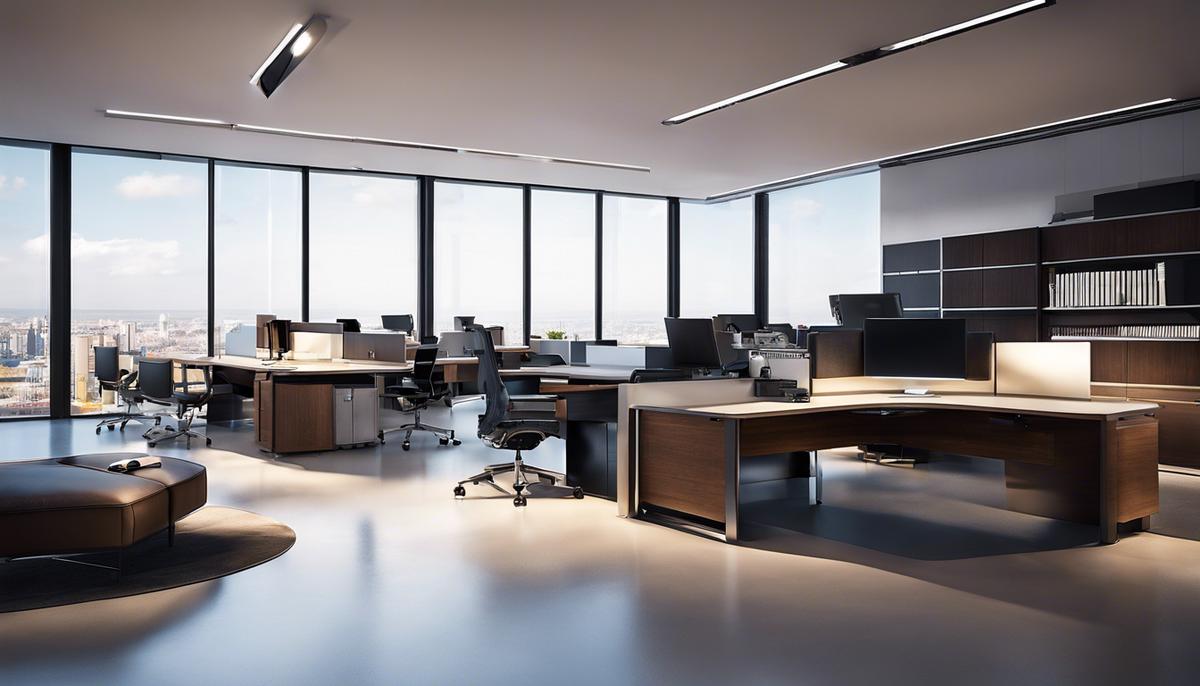
Innovative Ergonomic Design Elements
Title: Innovative Features That Are Revolutionizing Ergonomic Office Space Design
As an entrepreneur boasting a versatile understanding of market trends across sectors, one can’t ignore the sweeping wave of ergonomic improvements in office spaces. The dynamic intersection of design, technology, and psychology offers promising potential for organizations looking to harness the power of innovative ergonomics to optimize their office spaces.
Certainly, critical characteristics implementation in these workspaces could revolutionize your office environment and give your company the edge it needs to thrive in an increasingly competitive landscape. Let’s delve into these innovative features further.
The Utilization of Biophilic Designs
Biophilic designs aim to reconnect humans with nature within the urban office environment. Studies reveal that organized, green spaces help to reduce stress while promoting creativity. Features such as vertical green walls, strategically placed indoor plants, and décor inspired by nature significantly enhance the work environment and boost the overall employee well-being.
Human-Centric Lighting
Our circadian rhythm, otherwise known as our body clock, greatly influences our productivity and health, yet many businesses don’t realize the impact of lighting on their employees’ performance. Incorporating human-centric lighting that mimics natural daylight reduces eye strain and fatigue thus increasing concentration and productivity. Moreover, it supports a healthy sleep-wake cycle and promotes employees’ overall wellness.
Adoption of Formal-Informal Hybrid Layouts
Today’s agile businesses demand more flexible office layouts that cater to both formal and informal work requirements. This “hybrid” approach combines various zones like casual lounge areas, semi-private booths, and traditional open-plan spaces. This innovative model facilitates flexibility, enhances collaboration, and strikes a practical balance between privacy and openness.
The Office-on-Wheels Concept
Digitalization and technological advancements have paved the way for the exciting ‘office-on-wheels’ concept. Key office elements are designed to be mobile, enabling the formation and reformation of workspaces as required. Mobile workstations, foldable walls, and movable lounge spaces can accommodate several office layout configurations and meet distinctive work demands.
Utilization of Smart Office Technology
High-speed internet, wireless charging spots, and other smart office technologies significantly streamline work processes. Implementing IoT-based office design features such as smart climate control, intelligent security systems, and automated lighting not only increase energy efficiency and enhance security but also create an enriched work experience.
Revolutionizing office space design with the above ergonomic enhancements is not just a perk; it’s an imperative business strategy. Forward-thinking entrepreneurs understand the strength behind creating stimulating work environments and the powerful effect they have on productivity, engagement, and overall business growth. So, we encourage the pioneers out there to reconsider their office space design – because the ergonomically advanced office of the future is already here.
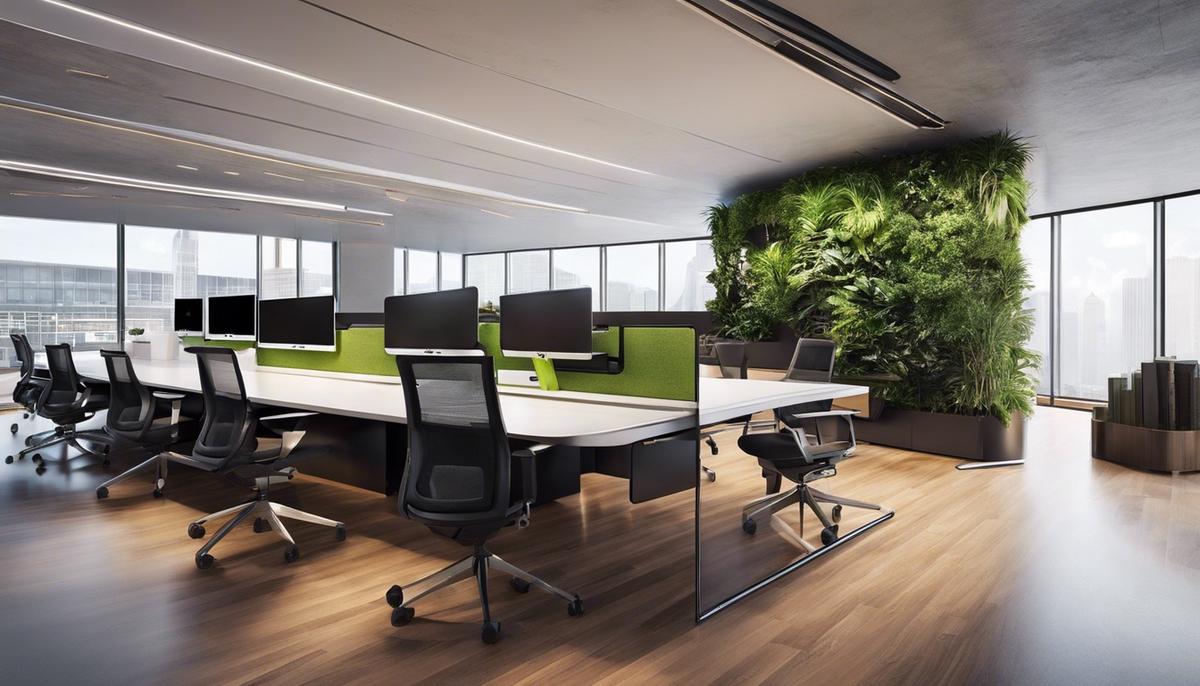
Investing in Ergonomic Office Space Design
In evaluating the potential return on investment (ROI) from ergonomic office space designs, savvy entrepreneurs not only take into account the health, engagement, and productivity of employees, but also strategize on its impact on business evolution. Notably, there are several key areas that businesses should focus on and can adopt: biophilic designs, human-centric lighting, hybrid layouts, office-on-wheels concept, and the application of smart office technology.
Integrating natural elements such as plants, water features, or daylight in office space designs, known as biophilic design, isn’t simply boosting morale — it’s a strategic investment. It’s been observed that workplaces with such designs report 13% higher levels of well-being and an 8% increase in productivity. Quantifying these improvements will inform clear-cut ROI calculations.
Human-centric lighting is an ergonomic design that prioritizes the impact of lighting on human physiology and well-being. Switching to LED from traditional lighting can result in energy savings of up to 50% and reduce maintenance costs up to 80%. Moreover, with better quality of light, companies report better mood, reduced fatigue, and increased performance.
Workplace designs like the formal-informal hybrid layout serve to foster a collaborative environment, balance privacy, and stimulate innovation. Google and LinkedIn report a 20-25% increase in productivity in such responsive workplaces. When calculating ROI, these jumps in productivity translate into direct financial measures.
The office-on-wheels concept marks the move from rigid partitions to modifiable spaces. This enables a flexible infrastructure that empowers teams to group and regroup with ease, thereby improving interdepartmental collaboration. The resultant synergy should be accounted for in the ROI evaluation.
Finally, a critical component in evaluating ROI from ergonomic designs is the implementation of smart office technologies. Incorporating technologies such as occupancy sensors, energy monitoring systems, automated lighting or heating can cut operational costs by as much as 18%. In today’s digital world where data is king, these technologies also provide invaluable metrics to further evaluate usage and efficiency. Furthermore, businesses can leverage on these metrics to further refine their office design strategy and to derive actionable insights.
While the initial investment in ergonomic office design may seem substantial, the long-term advantages demand acknowledgment. Astute businesses understand that the workplace design isn’t just about aesthetic appeal, but a strategic lever to pull for profitability, growth, and innovation. As organizations plan their workspace design strategy, a comprehensive evaluation of the ROI is of the essence. Thus, the potential return from an ergonomic office space is an equation of direct cost savings and the measurable upside on productivity, well-being and innovation.
Legal Aspects of Ergonomic Office Design
An entrepreneurial mindset never shies away from innovation, constantly seeking optimal means to not only fulfill but surpass market needs. This bold leadership principle unquestionably applies to ergonomic office design. The myriad benefits have been well documented, from skyrocketing productivity to a positive brand image and awe-inspiring workplace culture. There has been much chatter about biophilic designs, human-centric lighting, hybrid layouts, office-on-wheels, and smart technology. However, the intersection of innovation and implementation often trips in the form of legal considerations. Thus, unearthing the legal aspects intertwined with ergonomics becomes vital in this smart office ethos. Here’s what businesses need to know:
- Compliance with Occupational Safety and Health Administration (OSHA) Regulations:
OSHA has issued several guidelines regarding Ergonomics Program Management. While there are no specific regulations for ergonomics, the OSHA Act’s General Duty Clause (Section 5(a)(1)) mandates employers ensure their workplaces are free from recognized hazards causing, or are likely to cause death or serious physical harm. The improper ergonomic setup is identified as one such hazard. Thus, it’s imperative for businesses to ensure their office design aligns with the set guidelines, to avoid non-compliance penalties.
- The Americans with Disabilities Act (ADA) Considerations:
While considering ergonomic interventions, businesses must not overlook the legal obligations under the ADA. The workplace design should be accessible to all employees, including those with disabilities. Accommodations such as wide passageways, ramps, and wheelchair-accessible desks will need to be factored into the design.
- Liability for Work-Related Injuries:
Ergonomic office designs aim to lessen work-related musculoskeletal disorders. However, if due diligence is absent and employees are injured, businesses can face significant liability issues. Workman’s Compensation Insurance plays a crucial role here, shielding businesses against potentially crippling lawsuits.
- Employee Consent and Privacy Rights:
Human-centric lighting or smart office technologies undoubtedly boost efficiency. However, businesses need to consider employee privacy rights. Before implementing such solutions, obtaining employee consent is vital. Moreover, businesses have to ensure that these technologies don’t unduly infringe upon personal privacy, which could otherwise lead to potential legal backlash.
- Intellectual Property Right Issues:
In the business world, innovation is valuable and therefore, heavily protected. Businesses might face legal issues if any aspect of their innovative ergonomic design infringes upon the intellectual property rights of others. Therefore, adequate research, due diligence, and possibly legal advice are necessary before implementing a novel office design concept.
Remember, traversing the path of ergonomic office design is not just a choice but a business-friendly decision. Through strategic investments in ergonomics, businesses stand to reap substantial benefits, far outweighing the potential legal implications, provided they are judiciously navigated. Ergonomics is not a blanket approach. Tact, wisdom, and savvy are crucial to tailor-made solutions that satisfy the triple bottom line: People, Planet, and Profit.
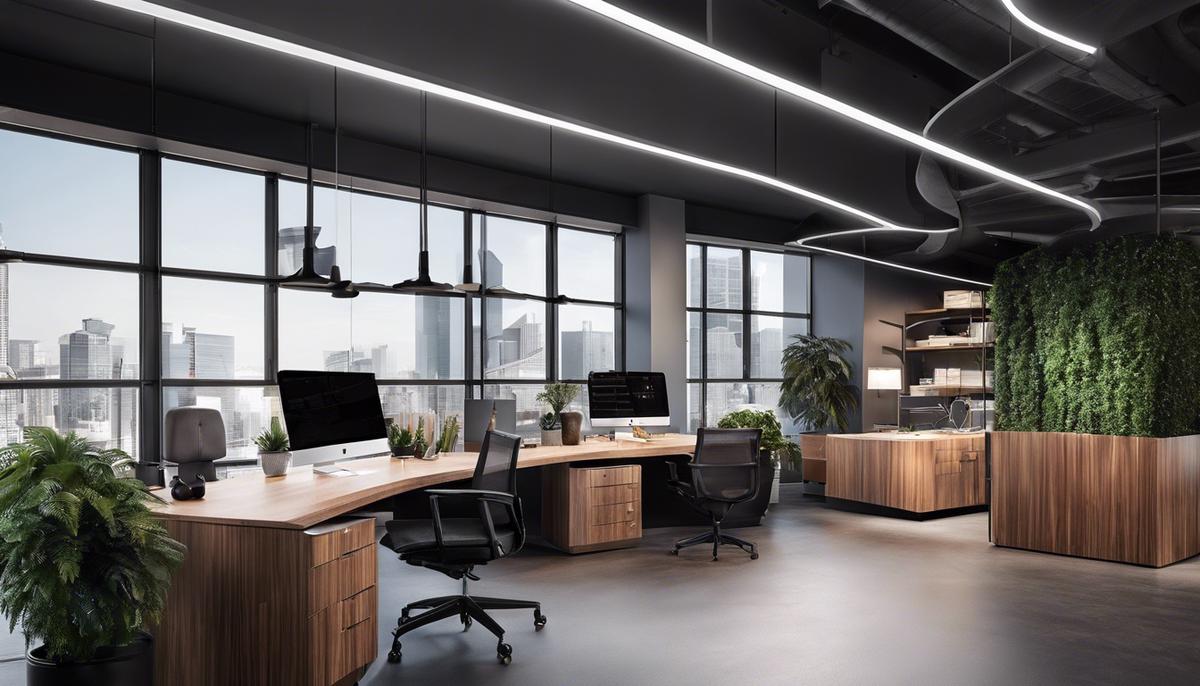
Converging Health and Business with Ergonomics
Contributing to the crusade of optimal workspace design, entrepreneurs must carefully deliberate compliance with the Occupational Safety and Health Administration (OSHA) regulations and the Americans with Disabilities Act (ADA) considerations. These acts are integral for defining the skeleton of a sturdy and functional ergonomic office design. Simultaneously, they establish the base line for a healthier workspace and also safeguard the business from witnessing a boom of workers’ compensation claims.
Adherence to these guidelines propels the corporate space towards a substantial reduction in work-related injuries. To put it simply, an ergonomic office design equipped to stave off injuries involuntarily imparts a protective sheath around the business as well, shielding it against potential financial liabilities.
A compliance-first approach is a savvy measure, allowing businesses to avoid a hemorrhage of funds tied to legal complications, but adequate investment must also be made in maintaining employee consent and privacy rights. The employee is, after all, quintessential in the whole scenario.
The implementation of certain office designs or technologies may be counterproductive if they encroach upon the rights or comfort of the employees. For instance, space-sharing cubicles might promote camaraderie, but may compromise individual privacy or personal work style, thereby failing in the long run. Instead of a boost, profitability might experience a slump due to low satisfaction rates and high turnover.
Moreover, innovation and patent rights procurement are compelling reasons to invest in an ergonomic workspace. This arrangement not only protects the organization’s intellectual property, but it also subtly encourages the sprouting of innovative ideas.
From compliance to caring for the workforce, each aspect of ergonomic office design contributes to the business’s bottom line. An enterprise that dwells on the intersection of employee wellbeing and profitability changes not just its own game, but sets new standards for the entire industry. By tapping into these benefits, entrepreneurs can maximize their returns sustainably while also fostering a flourishing, productive, and energetic workforce. It’s a win-win situation; healthier employees channel their optimal productivity into the enterprise, and in return, the business thrives.
In essence, ergonomic office design isn’t just a trend to jump on – it’s the golden bridge that integrates employee health into the core business strategy while redefining profitability in terms of holistic progress. Evidently, this is a bridge every forward-thinking business must dare to cross in pursuit of long-term success.
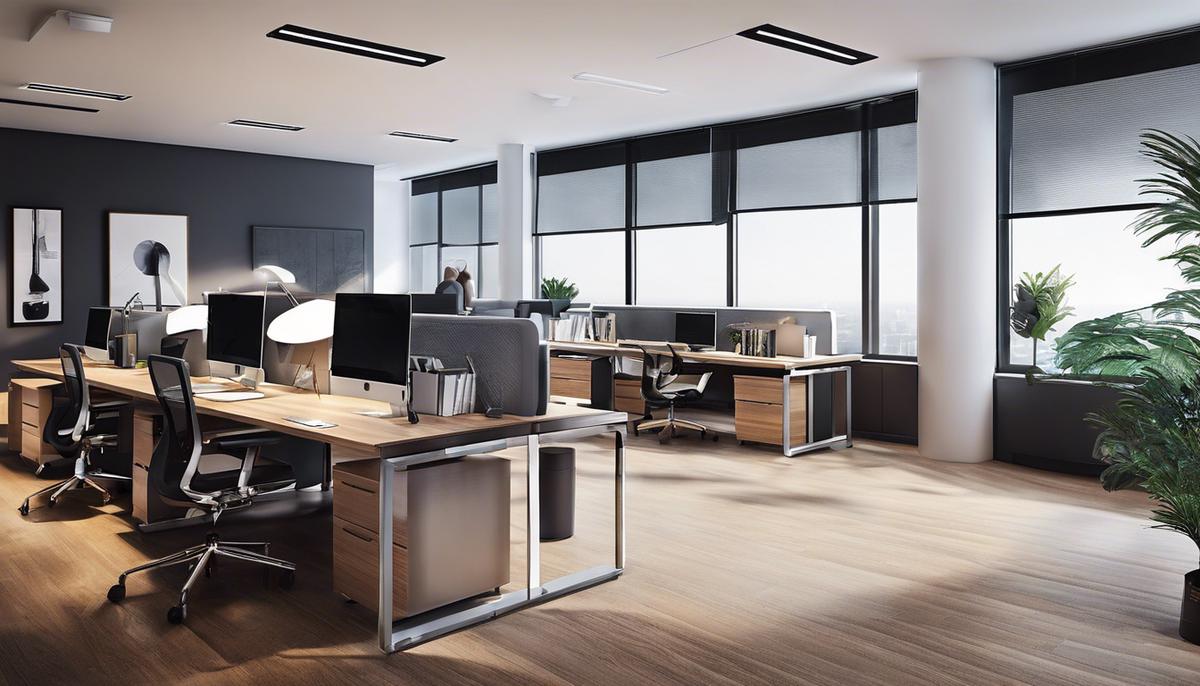
As the business world increasingly recognizes the link between employee health and company performance, a well-planned, ergonomic office environment emerges as a critical investment. The various strands of ergonomics – comfort, efficiency, health, and safety regulations – get woven into a fabric that enriches the workplace experience. The rewards extend from improved employee morale and productivity to a substantial return on investment and a robust legal position. The bottom line? Ergonomic office design isn’t a luxury—it’s an insightful business strategy that contributes to supporting a healthy and productive workforce, thus fostering a profitable business.
Disclaimer: This page contains links that are part of different affiliate programs. If you click and purchase anything through those links, I may earn a small commission at no extra cost to you. Click here for more information.
SUBSCRIBE TO TECHNOBRAX
If you want to receive updates whenever we post new articles or emails regarding discount deals on mice and keyboards, or other electronic devices CLICK HERE to SUBSCRIBE





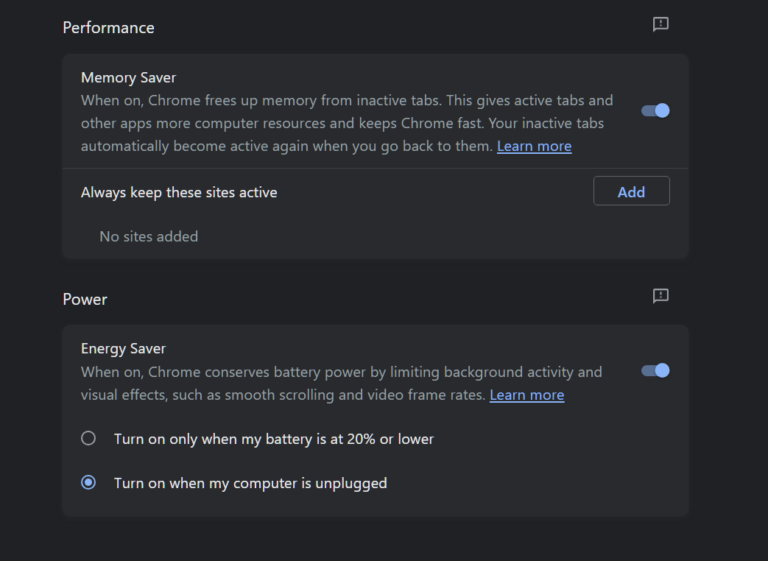
![[Steam Link] How to Play Steam Games on Your Phone?](https://technobrax.com/wp-content/uploads/2022/10/Screenshot_2022-10-04-18-30-24-971_com.valvesoftware.steamlink-1-768x355.jpg)
